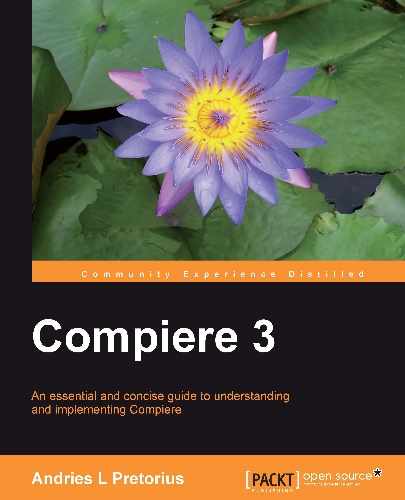In a world measured by money, all business processes materialize as an event in the accounting department. As a minimum, a budget is allocated to processes, or the financial impact of a process needs to be recorded in an Information System (ERP). The true power of Compiere is reflected in the intricate, flexible, and integrated information layers of its accounting engine. In the previous chapters we have described the sales cycle, inventory and purchasing cycle, and the accounting consequences of the relevant documents. In this chapter we explain the accounting and financial aspects of the system, and will do the following:
- Give you an overview of the Compiere accounting terminology
- Explain how accounting entries are derived
- Show you the accounting set-up required
- Explain open item management and the reconciliation of Accounts Receivable and Accounts Payable ledgers
- Explain cash management reconciliation
- Show you how to follow up on unposted documents
- Give you an overview of, and set up the financial reporting
In this chapter, we assume that you have a basic knowledge of accounting, and a working knowledge of Compiere List Reporting functionality.
In essence, Compiere adheres to the rule that accounting entries are at the lowest level, and an applicable document will have a derived accounting entry (fact). In order for you to understand the accounting process, there are Compiere accounting terms that must be clarified:
- Accounting schema: The set-up of the accounting schema defines the default rules and accounts of the Compiere tenant instance.
- Account elements: This refers to the natural account (debit or credit) used for the accounting balance entry (fact) posting. The posting to such elements can be actual, budget, or statistical. A chart of accounts is the listing of the account elements of the enterprise, which includes the account elements that make up the assets, liability, revenue, and expense accounts.
- Accounting fact: This refers to the accounting posting entry.
- Account combination: The account combination is a shortened reference (alias) to the accounting information dimension. For instance, telephone may refer to an account combination which would look like HQ-11100-Telephone-_-_-_.
- Trail balance: A trail balance report indicates the debit or credit balances of the list of accounts.
- Financial report: A financial report is run by a user and includes rows and columns that make up, for instance, Profit/Loss statement and balance sheet (financial position) reports.
- Re-posting accounts: This describes the action of re-posting a transaction document based on a new rule or default account that changed.
- Unposted document: These are documents that are entered and may be in a drafted or completed state, but for which the accounting engine has not generated the accounting entry. This could be due to a closed period, or because the accounting processor is not yet run.
- Document date versus Accounting date: Compiere documents usually allow for a document date and a separate accounting date field to be used for the accounting entry.
- Calendar year and period: While a transaction will fall into a period, the calendar period is used for control and reporting purposes. There is no end of period or roll-over process as such in Compiere.
